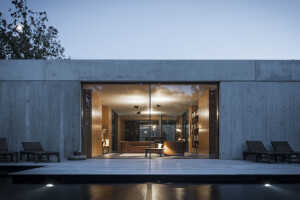The building for the research laboratories of the National Institute for Biotechnology in the Negev (NIBN), is situated at the southwestern corner of the Ben-Gurion University campus. The edifice is a part of the university’s laboratory buildings complex and is connected to it by a covered walkway.
The NIBN building is comprised of four levels: three for laboratories and researchers' offices, standing above a transparent ground floor for general public functions such as foyer,faculty lounge, auditorium, cafeteria, and seminar room.These latter operationsallow for increased interaction between researchers, thereby enhancing the exchange of knowledge and strengthening academic tiesacross disciplines. The ground floor's envelopecombines transparent glass façades and exposed concrete walls. The glass façades establish viewingrelations between the surrounding urban environment and inner campus areas, dissolving the barrier between them. The exposed concrete walls form a stylistic and material continuation with the neighboring campus buildings. Adjacent to the foyer is a sizeable garden, partly covered by the upper laboratories floors, which creates an inviting and comfortable space for outdoor activities and bestows a sense of tranquility over the building as a whole.
The upper floors are organized around a square space that forms an elevated open-air atrium. Their design is modular and flexible so as to accommodate programmatic changes in terms of laboratory type and size. The laboratories and offices are located at the building’s periphery, whilethe social spaces with their glass facades and the auxiliary rooms with their plastered walls face the atrium and have views upon the garden. A double skin system serves as this section’s envelope, enabling the inner spaces to receive their appropriate exposure to sunlight.This façade consists of an internal glazed curtain wall and an external layer of green u glass, which is perforated by vertical openings of acid u glass louvers that expose the building's population to the landscape.












































